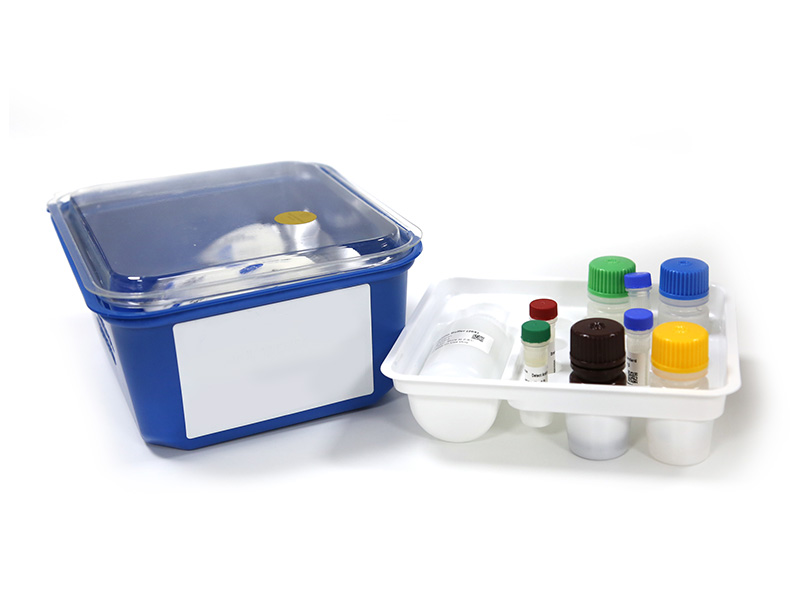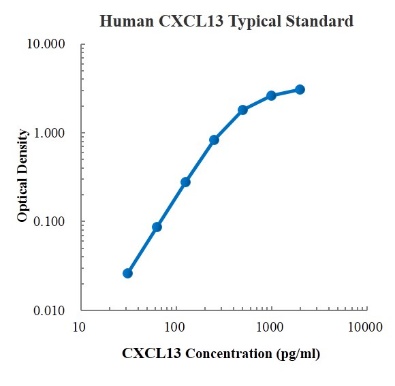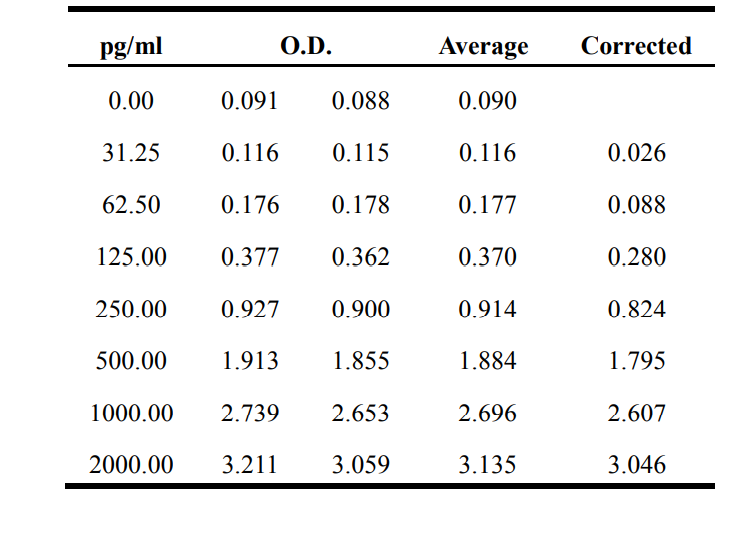
Human CXCL13/BLC/BCA-1 ELISA Kit
$350.00 – $450.00
| Sample Type | Serum, plasma, cell culture supernatant, and other biological samples |
|---|---|
| Sample Volume | 20 μL |
| Sensitivity | 4.86 pg/mL |
| Range | 31.25 pg/mL – 2000 pg/mL |
| Assay Time | 3.5 h |
| Recovery | 87% – 114% |
| Average Recovery | 0.99 |
| Intra Precision | 1.3% – 6.5% |
| Inter-Precision | 2.7% – 4.9% |
| Platform | ELISA |
| Plate | Detachable 96-well plate |
| Size | 96T/48T |
| Storage | If the reagent kit is unopened, it should be stored at 4℃. However, if it has been opened, the standard solution should be stored at -20℃, while the other components should be stored at 4℃. |
| Delivery | 4℃ blue ice transportation |
| Components | 96-well polystyrene enzyme-linked immunosorbent assay (ELISA) plate coated with anti-CXCL13/BLC/BCA-1 monoclonal antibody Human CXCL13/BLC/BCA-1 freeze-dried standard CXCL13/BLC/BCA-1 detect Antibody Standard Diluent Assay Buffer(10×) Substrate TMB Stop Solution Washing Buffer(20×) Sealing Film |
| Assay Principle | This kit utilizes the double antibody sandwich enzyme-linked immunosorbent assay (ELISA) detection technique.Specific anti-human CXCL13 antibodies are precoated on a high-affinity ELISA plate. Standard samples, test samples, and biotinylated detection antibodies are added to the wells of the ELISA plate. After incubation, CXCL13 present in the samples binds to the solid-phase antibodies and the detection antibodies. After washing to remove unbound substances, streptavidin-HRP labeled with horseradish peroxidase is added. After washing, a colorimetric substrate, TMB, is added and the plate is incubated in the dark for color development. The intensity of the color reaction is directly proportional to the concentration of CXCL13 in the samples.A stop solution is added to terminate the reaction, and the absorbance value is measured at a wavelength of 450 nm (with a reference wavelength range of 570-630 nm). |
Targets
CXCL13
CXCL13 Target Infomation Overview
- Target Symbol: CXCL13, C-X-C motif chemokine ligand 13
- Gene Groups: Chemokine ligands
- Alias: BLC; BCA-1; BLR1L; ANGIE; ANGIE2
- Previous Names: SCYB13
- Alias Names: B-cell chemoattractant; small inducible cytokine B subfamily (Cys-X-Cys motif), member 13 (B-cell chemoattractant); chemokine (C-X-C motif) ligand 13
CXCL13, C-X-C motif chemokine ligand 13 Target Infomation by Species
[su_tabs][su_tab title=”Human” disabled=”no” anchor=”” url=”” target=”blank” class=”tab-human”]
Human CXCL13 Target Information
- Target Symbol: CXCL13, C-X-C motif chemokine ligand 13
- Alias:
- ANGIE
- ANGIE2
- b cell-attracting chemokine 1
- b lymphocyte chemoattractant
- B-cell chemoattractant
- B-cell-attracting chemokine 1
- B-cell-homing chemokine (ligand for Burkitt’s lymphoma receptor-1)
- B-lymphocyte chemoattractant
- BCA-1
- BCA1
- BLC
- BLR1L
- C-X-C motif chemokine 13
- chemokine (C-X-C motif) ligand 13 (B-cell chemoattractant)
- CXC chemokine BLC
- SCYB13
- small inducible cytokine B subfamily (Cys-X-Cys motif), member 13 (B-cell chemoattractant)
- small-inducible cytokine B13
- NCBI_Gene: 10563
- UniProtKB: O43927
Human CXCL13 Predicted Functions
Enables chemokine receptor binding activity; fibroblast growth factor binding activity; and heparin binding activity. Involved in several processes, including antimicrobial humoral immune response mediated by antimicrobial peptide; cell chemotaxis; and regulation of chemotaxis. Located in extracellular region.
[/su_tab]
[su_tab title=”Mouse” disabled=”no” anchor=”” url=”” target=”blank” class=”tab-mouse”]
Mouse Cxcl13 Target Information
- Target Symbol: Cxcl13, chemokine (C-X-C motif) ligand 13
- Alias:
- 4631412M08Rik
- ANGIE2
- BCA-1
- BLC
- RIKEN cDNA 4631412M08 gene
- Scyb13
- small inducible cytokine subfamily B (Cys-X-Cys), member 13
- NCBI_Gene: 55985
Mouse Cxcl13 Predicted Functions
Enables CXCR5 chemokine receptor binding activity and chemokine activity. Involved in several processes, including B cell chemotaxis across high endothelial venule; activation of GTPase activity; and lymph node development. Located in extracellular space. Is expressed in Peyer’s patch; aorta; central nervous system; and retina. Orthologous to human CXCL13 (C-X-C motif chemokine ligand 13).
[/su_tab]
[su_tab title=”Rat” disabled=”no” anchor=”” url=”” target=”blank” class=”tab-rat”]
Rat Cxcl13 Target Information
- Target Symbol: Cxcl13, C-X-C motif chemokine ligand 13
- Alias:
- C-X-C motif chemokine 13
- chemokine (C-X-C motif) ligand 13
- LOC498335
- similar to Small inducible cytokine B13 precursor (CXCL13) (B lymphocyte chemoattractant) (CXC chemokine BLC)
- NCBI_Gene: 498335
Rat Cxcl13 Predicted Functions
Predicted to enable chemokine receptor binding activity; fibroblast growth factor binding activity; and heparin binding activity. Predicted to be involved in several processes, including cell chemotaxis; regulation of chemotaxis; and response to bacterium. Predicted to act upstream of or within lymph node development. Predicted to be located in extracellular region. Predicted to be active in extracellular space. Orthologous to human CXCL13 (C-X-C motif chemokine ligand 13).
[/su_tab][/su_tabs]
CXCL13 Target News
[catlist tags=”cxcl13″ template=targetnews thumbnail=yes thumbnail_class=”related-post-media clr” thumbnail_size=833]





